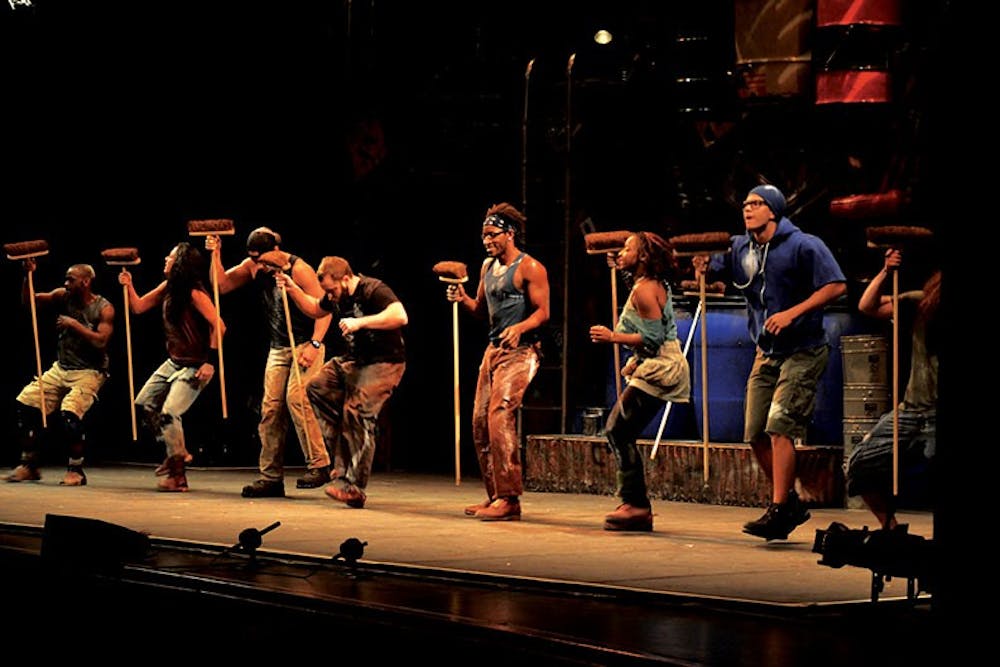A boisterous crowd on Wednesday night provided proof of the ongoing popularity for the theatrical show “Stomp.” The sold-out performance attracted an audience of all ages to Shippensburg’s H. Ric Luhrs Performing Arts Center.
The stage curtain was already open as the crowd entered Grove Auditorium, and music from a massive sound system played, while they found their seats. The stage set, primarily the back wall, showed an urban setting of alleys and building walls, visible and subtly lit with a few colored lights. Wall panels of trash and found items are displayed like art — road signs, hubcaps, pots and pans and buckets and cans, instead of children’s art and family photos.
No words were spoken or sung during the entire show, although there were some non-verbal sounds for effect. There was no band — no traditional musical instruments, at all. In fact, for all the sound and volume, everyday-items found anywhere created everything the audience heard.
The lights dimmed, and a solitary performer came out, sweeping the stage with a push broom. Microphones on the stage helped the audience pick up every sound with perfect clarity: the sound of shoes on the floor and, like brushes on a snare drum, and the swish-swish sound of the broom.
The sound became rhythmic, with a bang of the wooden part of the brush joining the swish of the bristles, and the taps of the performer’s shoes added a clipped cymbal in counterpoint. A second performer came out and then a third — a fourth, a fifth, a sixth, including one who climbs down the back wall — all playing their brooms in a street symphony, sometimes in unison, sometimes adding extra emphasis.
A spotlight appeared front and center and one member of the cast with a broom in each hand, performed a complicated pattern. Next, four performers used matchboxes, tapping, scratching and shaking like a Cuban rhythm section. One performed a lightning fast “hambone,” using only his hands to clap and beat a rhythm on his own body. Then, without saying a word, he got the audience to participate, increasing the complexity of the sounds until the crowd was hopelessly lost in trying to keep up, eventually breaking down into laughter at themselves.
Other numbers included a sawdust-on-the-floor soft-shoe dance, with lots of humorous physical comedy. There was a nearly war-like Polynesian tribal dance, as the cast appeared to be attacking each other, while broom handles banged and clacked. Collapsible ribbed-tubing was played like accordions, and there was a section where the props were grocery carts, sticks and 5-gallon water bottles.
One of the most visual moments occurred in near dark, as a dozen performers stood at the front of the stage and lit up old-fashioned metal lighters that clicked when the lids were opened and closed. It looked like a string of Christmas lights sequenced by a mad scientist.
Basketballs as rhythm instruments? As a group, they dribbled six of them, sounding like a complex beat box, together. Then, in a competing beat, they juggled and passed the basketballs like the Harlem Globetrotters.
The finale was a trashcan portion of the program. Trashcans and lids were used in a manic drum line, beaten by sticks or against each other, with bright stage lights reflecting off them out into the audience.
For the encore it was, once again, audience participation time, with the cast clapping or beating out a rhythm for the crowd to repeat. “Stomp” originated in the United Kingdom. After a 10-year collaboration, Luke Cresswell and Steve McNicholas created the show in 1991. Since then, the show’s five touring groups have traveled all over the world, with stops in Paris, Las Vegas, Tokyo, Singapore, Sydney and New York. The group has won quite a few awards, along the way, including an Obie and a Drama Desk Award. One of the group’s short films was nominated for an Academy Award and was screened at the Sundance and Cannes Film Festivals. Forty cast members performed at the 2012 London Olympic Games.
For more information visit stomponline.com.




The Slate welcomes thoughtful discussion on all of our stories, but please keep comments civil and on-topic. Read our full guidelines here.